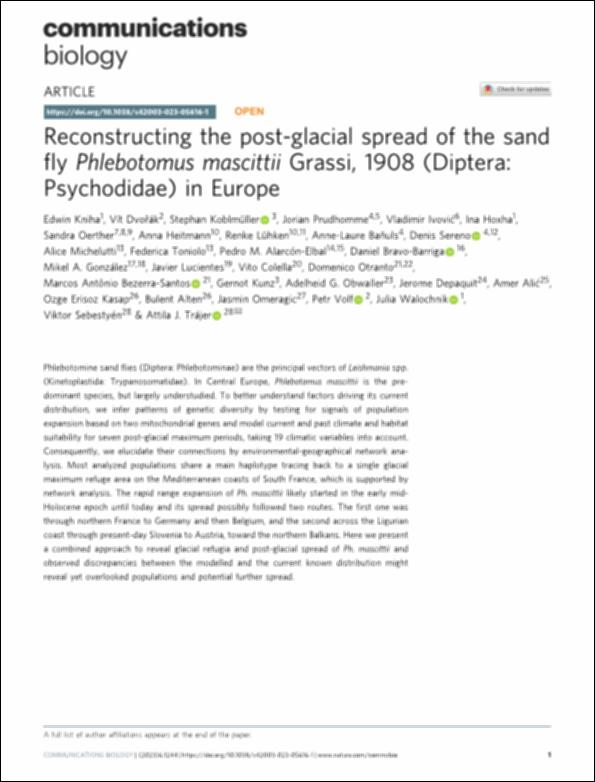Por favor, use este identificador para citar o enlazar este ítem:
http://hdl.handle.net/10637/15336Reconstructing the post-glacial spread of the sand fly "Phlebotomus mascittii" Grassi, 1908 (Diptera: Psychodidae) in Europe
| Título : | Reconstructing the post-glacial spread of the sand fly "Phlebotomus mascittii" Grassi, 1908 (Diptera: Psychodidae) in Europe |
| Autor : | Kniha, Edwin Dvorák, Vít Koblmüller, Stephan Prudhomme, Jorian Ivović, Vladimir Hoxha, Ina Alarcón Elbal, Pedro María González, Mikel Alexander |
| Materias: | Enfermedades parasitarias; Parasitic diseases; Animales vectores; Animals as carriers of disease; Insecto; Insects; Zoonosis; Zoonoses |
| Editorial : | Springer Nature |
| Citación : | Kniha, E., Dvořák, V., Koblmüller, S., Prudhomme, J., Ivović, V., Hoxha, I., Oerther, S., Heitmann, A., Lühken, R., Bañuls, A.L., Sereno, D., Michelutti, A., Toniolo, F., Alarcón-Elbal, P.M., Bravo-Barriga, D., González, M.A., Lucientes, J., Colella, V., Otranto, D., Bezerra-Santos, M.A., … Trájer, A.J. (2023). Reconstructing the post-glacial spread of the sand fly "Phlebotomus mascittii" Grassi, 1908 (Diptera: Psychodidae) in Europe. Communications Biology, vol. 6, i. 1, art. 1244 (08 dec.). DOI: https://doi.org/10.1038/s42003-023-05616-1 |
| Resumen : | Phlebotomine sand flies (Diptera: Phlebotominae) are the principal vectors of Leishmania spp. (Kinetoplastida: Trypanosomatidae). In Central Europe, Phlebotomus mascittii is the predominant species, but largely understudied. To better understand factors driving its current distribution, we infer patterns of genetic diversity by testing for signals of population expansion based on two mitochondrial genes and model current and past climate and habitat suitability for seven post-glacial maximum periods, taking 19 climatic variables into account. Consequently, we elucidate their connections by environmental-geographical network analysis. Most analyzed populations share a main haplotype tracing back to a single glacial maximum refuge area on the Mediterranean coasts of South France, which is supported by network analysis. The rapid range expansion of Ph. mascittii likely started in the early mid-Holocene epoch until today and its spread possibly followed two routes. The first one was through northern France to Germany and then Belgium, and the second across the Ligurian coast through present-day Slovenia to Austria, toward the northern Balkans. Here we present a combined approach to reveal glacial refugia and post-glacial spread of Ph. mascittii and observed discrepancies between the modelled and the current known distribution might reveal yet overlooked populations and potential further spread. |
| URI : | http://hdl.handle.net/10637/15336 |
| Derechos: | Open Access http://creativecommons.org/licenses/by/4.0/deed.es |
| ISSN : | 2399-3642 (Electrónico) |
| Fecha de publicación : | 8-dic-2023 |
| Centro : | Universidad Cardenal Herrera-CEU |
| Aparece en las colecciones: | Dpto. Producción y Sanidad Animal, Salud Pública Veterinaria y Ciencia y Tecnología de los Alimentos |
Los ítems de DSpace están protegidos por copyright, con todos los derechos reservados, a menos que se indique lo contrario.


